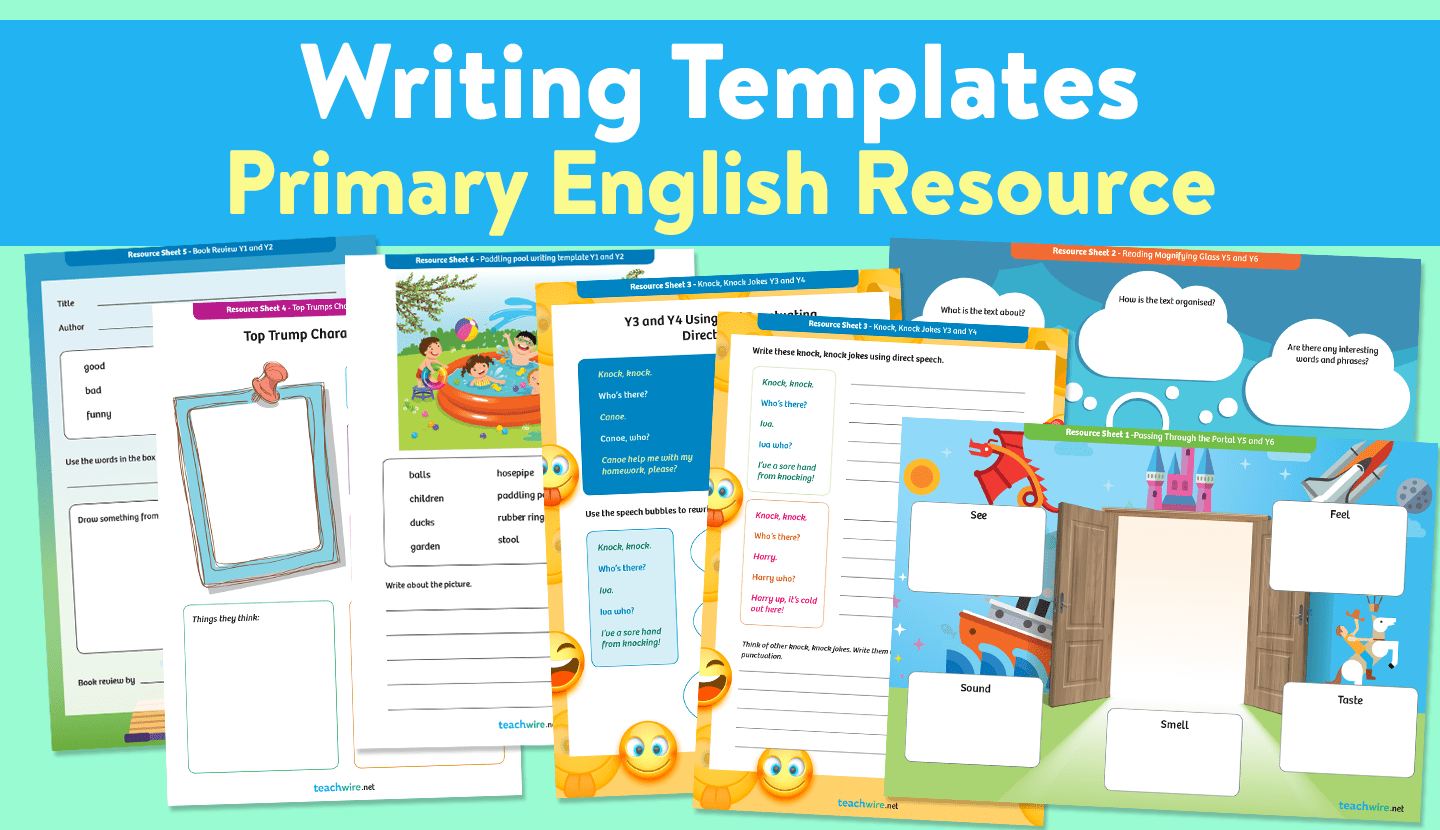Six PDF writing templates and a PDF cover sheet guide
KS1, KS2
Years 1-6
When children are struggling to get their thoughts down on the page, a little structure via a writing template can work wonders, says Rachel Clarke…
Whichever type of writing I’m doing, it’s the getting started that’s the hardest thing to do. This is why a writing template can be so useful. It helps inexperienced writers get started and to write for a variety of purposes and audiences.
We’ve got a writing template here for both KS1 and KS2 – two for KS1, two for lower KS2 and two for upper KS2. And because not all children are the same, we’ve differentiated three of these templates (one for each age group).
Writing template downloads
Passing through the portal – Y5/6
When the Pevensey children discovered Narnia, they did so by opening the door of the wardrobe. Similarly, Alice stole her first glimpse of Wonderland after falling down the rabbit hole and peering through the keyhole. Authors frequently use doors and portals to structure fantasy stories, making them useful devices for KS2 descriptive writing.
When planning to use portals with children, first work out what the portal will be, where it is located and what it looks like. As a class you should then decide where in the narrative to introduce the portal, what is on the other side and how you’ll use the portal to return to the original setting.
When it comes to describing what is on the other side, most children benefit from working as a class or group to examine images of settings and brainstorming descriptive phrases about them. Once they’ve done this, they’re ready to invent their own settings.
Reading magnifying glass – Y5/6
Using a ‘magnifying glass’ to analyse text is a pupil-friendly way to promote close reading skills. If you’ve not followed the structure of this type of activity before, it’s a technique that promotes deeper understand of text through re-reading.
On the first reading, encourage pupils to articulate what the text is about and to notice its organisational features. Then direct them to read the text again; this time noticing the author’s use of words and phrases and the effectiveness of these.
Finally, ask pupils to read the text a third time; this time taking account of the author’s point of view and commenting on how they connect with the text personally.
Knock, knock jokes – Y3/4
To many children, the rules and conventions of direct speech are an unfathomable challenge of where and when to use commas, inverted commas, full stops and capital letters. Enter the humble knock, knock joke.
First off, knock, knock jokes feature two speakers, so there’s no need to contrive an awkward conversation for children to ‘turn into speech’. Secondly, the page layout mirrors the rules of dialogue with a new line for each line of the joke. And thirdly, children like knock, knock jokes.
The resource sheet accompanying this article uses a small-steps approach to slowly scaffold children through the rules and conventions of dialogue. In the first instance simply ask pupils to rewrite knock, knock jokes in speech bubbles.
Once they’ve got the hang of this, encourage them to write the name of the speaker and ‘said’ before each speech bubble. The second level asks pupils write each line of the knock, knock joke using inverted commas.
Each example on this sheet starts with the reporting clause before the dialogue, which enables pupils to practise adding a comma after the reporting clause.
Additionally, encourage pupils to use a range of synonyms for ‘said’ at this point. Once secure in setting out and punctuating direct speech with the reporting clause before the dialogue, show pupils how to add the reporting clause after the dialogue.
This means learning to use a comma before the closing inverted commas and not capitalising the first word after the inverted commas – unless, of course, it’s a name. So many rules!
Top Trumps character profiles – Y3/4
Creating characters using the popular Top Trumps format is a useful way to encourage pupils to think beyond the appearance of their characters and whether they’re adventurous, brave, cowardly or cruel, for example, and to consider their feelings, thoughts and motivations.
As we’ve already seen in this article, using and punctuating direct speech is a significant objective for pupils in lower KS2.
By including space to plan what characters say, the Top Trumps Character profile encourages pupils to include direct speech in their narratives and so create characters with physical presence beyond their appearance.
I find it’s always best to model using a writing template such as this one so that pupils know how to get the most from it.
Once I’ve completed a planning profile with pupils, I then model using it to write effective character descriptions, showing how to include aspects of character through my descriptions of actions, thoughts and dialogue.
Book review – Y1/2
Writing book reviews enables pupils to offer opinions based on first-hand experiences. Naturally, you shouldn’t expect pupils to review every book they read, but from time to time encouraging them to reflect on their reading is a useful activity.
As pupils are required to offer opinions when reviewing their reading, book reviews provide valuable practice at using the subordinating conjunction ‘because’. This makes them particularly useful teaching tools for meeting the writing requirements of KS1.
Swimming pool writing prompt – Y1/2
Use stories the class have heard, activites you’ve shared or artefacts and images you’ve looked at to stimulate writing opportunities. This paddling pool writing prompt enables children to write from a visual cue.
First off, encourage children to talk about what they can see in the picture. You may need to expand their vocabularies by naming objects such as the hosepipe and the stool.
You may also want to draw on the prior knowledge of children who have played in a paddling pool, sharing their experiences such as splashing in the water, taking care not to slip as they got in and out and shivering if the water felt chilly.
Encourage children to phrase their observations as sentences and model writing these on the flipchart or whiteboard. Now ask children to write about the picture using the keywords to help them where necessary.
Rachel Clarke is the director of Primary English Education Consultancy Limited. She works with schools across the UK and is the author of several books. Browse more creative writing prompts.

Similar resources
- No Refuge – Graphic novel activities about refugees for UKS2
- Short story writing – Author-led resources for KS1 and KS2
- Christmas activity sheets – KS1 / KS2 fun & educational printables
- Learning gaps – How to ensure no pupil drifts too far
- Writing horror – Write a scary scene with Fear Files: Hide & Seek













